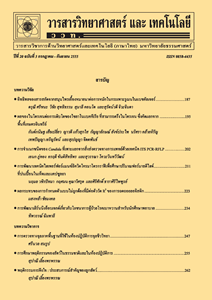การสังเคราะห์เชื้อเพลิงเหลวจากน้ำมันหล่อลื่นที่ใช้แล้วโดยกระบวนการไพโรไลซิส
Main Article Content
Abstract
Abstract
Pyrolysis reaction of waste lubricant oil was studied in a fixed-bed reactor both with and without the presence of a catalyst in the temperature range of 300-400 oC under nitrogen atmosphere. Products are contained two parts including gas and liquid. Liquid products consist of gasoline-like fuel (C7-C10), jet oil-like fuel (C11-C15) and diesel-like fuel (C15-C20), which are desirable for liquid fuels. From the experimental study, the amount of gas product increases with temperature. Additionally, under these studied conditions the amount of gas product in the system without any catalysts was almost the same, approximately 50 wt%. However, for the catalytic system it was found that activated carbon is more suitable for pyrolysis reaction than zeolite catalyst. The optimum operating conditions in this study was at temperature of 400 oC over activated carbon. Liquid products consisting of gasoline-like fuel, jet oil-like fuel and diesel-like fuel are 42, 12, and 14 wt% respectively.
Keywords: pyrolysis; waste lubricating oil; activated carbon; y-zeolite; synthetic fuel
Article Details
References
[2] Siriporn Kansiya, 2003, Waste lube oil management, Environ. J. 7(26): (in Thai)
[3] Ali, M.F., Rahman, F. and Hamdan, A.J., 1995, Techno-economic evaluation of waste lube oil refining, Int. J. Prod. Econ. 42: 263-273.
[4] News: Sustainaility at Chulalongkorn University, Available Source: http://www. green.chula.ac.th/news012.html.
[5] Wisa Manasomboonphan, S.J., 2556, Study on optimum pyrolytic conditions of waste lube oil for producing liquid fuel, ว.วิทยาสตร์ลาดกระบัง.
[6] Khowatimy, F.A., Yoga Priastomo, E.F., 2014, Study of waste lubricant hydrocracking into fuel fraction over the combination of Y-Zeolite and ZnO catalyst, Proc. Environ. Sci. 20: 225-234.
[7] Lam, S.S., Russell, A.D., Lee, C.L. and Chase, H.A., 2012, Microwave-heated pyrolysis of waste automotive engine oil: Influence of operation parameters on the yield, composition, and fuel properties of pyrolysis oil, Fuel 91: 327-339.
[8] Loiha, S., 2556, Zeolite and Zeolite Technology, KKU Sci. J. 41(1): 56-66.
[9] Dimitar Georgiev, B.B., 2009, Synthetic Zeolites-Structure, Classification, Current Trends in Zeolite Synthesis, Economics and Society development on the Base of Knowledge, Bulgaria.
[10] Yoomee, P., 2015, Preparation of activated carbons with high surface area from wood charcoal powder by dry chemical activation, KKU Sci. J. 43: 788-798.
[11] Croswel Aguilar, R.G.G., 2003, Catalytic wet air oxidation of aqueous ammonia with activated carbon, Appl. Catal. B Environ. 46: 229-237.
[12] Seghers, L.P., 2016, Improving the efficiency of the Diels–Alder process by using flow chemistry and zeolite, Royal Soc. Chem. Catal. 19: 237-248.
[13] Lam, S.S., Liew, R.K., Cheng, C.K. and Chase, H.A., 2015, Catalytic microwave pyrolysis of waste engine oil using metallic pyrolysis char, Appl. Catal. B Environ. 176-177: 601–617.

